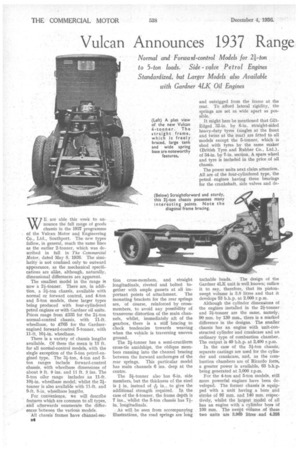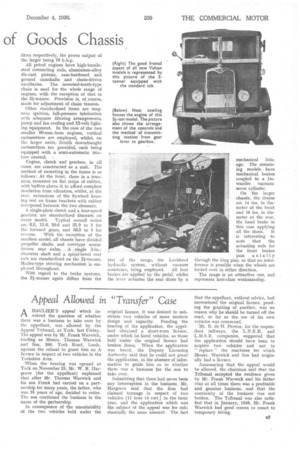Vulcan Announces 1937 Range of Goods Chassis
Page 40

Page 41

If you've noticed an error in this article please click here to report it so we can fix it.
Normal and Forward-control Models for 2t12-ton to 5-ton loads. Side valve Petrol Engines Standardized, but Larger Models also Available with Gardner 4LK Oil Engines WE are able this week to announce the full range of goods chassis in the 1937 programme of the Vulcan Motor and Engineering Co., Ltd., Southport. The new types follow, in general, much the same lines as the earlier 2-tonner, which was described in full in The Commercial Motor, dated May 8, 1936. The similarity is not confined only to outward appearance, as the mechanical specifications are alike, although, naturally, dimensional differences are apparent.
The smallest model in the range is now a 21-tonner. There are, in addition, a 31-ton chassis, available with normal or forward control, and 4-ton and 5-ton models, these larger types being produced with four-cylindered petrol engines or with Gardner oil units. Prices range from £335 for the 21-ton normal-control chassis, with 11-ft. wheelbase, to £765 for the Gardnerengined forward-control 5-tonner, with 11-ft. 101-in. wheelbase.
There is a variety of chassis lengths available. Of these the mean is 13 ft. for all normal-control models, with the single exception of the 5-ton petrol-engined type, The .11-ton, 4-ton and 5ton ranges include forward-control chassis, with wheelbase dimensions of about 9 ft. 9 ins. and 11 ft. 3 ins. The 5-ton oiler range includes an 11-ft. 101-in. wheelbase model, whilst the 21tonner is also available with 11-ft. and 9-ft. 8-in, wheelbase lengths.
For convenience, we will describe features which are common to all types, and afterwards enumerate the differences between the various models.
All chassis frames have channel-secPS tion cross-members, and straight longitudinals, riveted and bolted together with ample gussets at all important points of attachment. The mounting brackets for the rear springs are, of course, reinforced by crossmembers, to avoid any possibility of transverse distortion of the main channels, whilst, immediately aft of the gearbox, there is a stiff bracing to check tendencies towards weaving when the vehicle is traversing uneven ground.
The 21-tonner has a semi-cruciform cross-tie amidships, the oblique members running into the channel bracing between the forward anchorages of the rear springs. This particular model has main channels 6 ins, deep at the centre.
The 31-tonner also has 6-in, side members, but the thickness of the steel
is in, instead of in., to give the additional strength required. In the case of the 4-tonner, the frame depth is 7 ins., whilst the 5-ton chassis has 71in. longitudinals.
As will be seen from accompanying illustrations, the road springs are long and outrigged from the frame at the rear. To afford lateral rigidity, the springs are set as wide apart as possible.
It might here be mentioned that GiltEdged 32-in. by 6-in, straight-sided heavy-duty tyres (singles at the front and twins at the rear) are fitted to all models except the 5-tormer, which is shod with tyres by the same maker (British Tyre and Rubber Co., Ltd.), of 34-in. by 7-in. section. A spare wheel and tyre is included in the price of all chassis.
The power units next claim attention. All are of the four-cylindered type, the petrol engines having three bearings for the crankshaft, side valves and de tachable heads. The design of the Gardner 4LK unit is well known; suffice it to say, therefore, that its pistonswept volume is 3.8 litres and that it develops 53 b.h.p. at 2,000 r.p.m.
Although the cylinder dimensions of the engines installed in the 21-tonner and 31-tonner are the same, namely, 90 mm. by 130 mm., there is a marked difference in the designs. The smaller chassis has an engine with unit-constructed cylinder and crankcase and an ordinary type of combustion chamber. The output is 49 b.h.p. at 2,400 r.p.m.
In the case of the 31-ton chassis, separate castings are used for the cylinder and crankcase, and, as the combustion chambers are of Ricardo form, a greater power is available, 63 b.h.p. being generated at 3,000 r.p.m.
For the 4-ton and 5-ton models, still more powerful engines have been developed. The former chassis is equipped with a unit having a bore and stroke of 95 mm. and 140 mm. respectively, whilst the largest model of all has an engine with a cylinder bore of 100 mm. The swept volume of these two units are 3.969 litres and 4.398
litres respectively, the power output of the larger being 76 b.h.p.
All petrol engines have high-tensilesteel connecting rods, aluminium-alloy die-cast pistons, case-hardened and ground camshafts and chain-driven auxiliaries. The inverted-tooth-type chain is used for the whole range of engines, with the exception of that in the 2i-tonner. Provision is, of course, made for adjustment of chain tension.
Other standardized items are magneto ignition, full-pressure lubrication with adequate filtering arrangements, pump and fan cooling and 12-volt lighting equipment. In the case of the two smaller ,90-mm.-bore engines, vertical carburetters are employed, whilst, on the larger units, Zenith downdraught carburetters are provided, each being equipped with a semi-automatic mixture control.
Engine, clutch and gearbox, in all cases, are constructed as a unit. The method of mounting in the frame is as follows : At the front, there is a trunnion, mounted on flat strips of rubber, with buffers above it to afford complete insulation from vibration, whilst, at the rear, extensions of the flywheel housing rest on frame brackets with rubber interposed between the two elements.
A single-plate clutch and a four-speed gearbox are standardized fitments on every mode/. Typical overall ratios are 615, 12.6, 20.6 and 35.9 to 1 for the forward gears, and 56.5 to 1 for reverse. With the exception of the smallest model, all chassis have divided propeller shafts and overtype wormdriven rear axles..,. A %single 3-in.diameter shaft and a spiral-bevel rear axle are standardized on the 2i-tonner. Manes-type steering mechanism is employed throughout.
With regard to the brake systems, the 21-tonner again differs from the rest of the range, the Lockheed hydraulic system, without vacuum assistance, being employed. All four brakes are applied by the pedal, whilst the lever actuates the rear shoes by a mechanical linkage. The remaining models have mechanical brakes coupled to a Dewandre vacuumservo cylinder.
On the larger chassis, the drums are 14 ins. in diameter at the front and 16 ins, in diameter at the rear, the hand brake in this case applying all the shoes. It is interesting to note that the actuating rods for the front brakes pass axially through the king pins, so that no interference is possible when the wheels are locked over in either direction.
The range is an attractive one, and represents first-class workmanship.




























































































